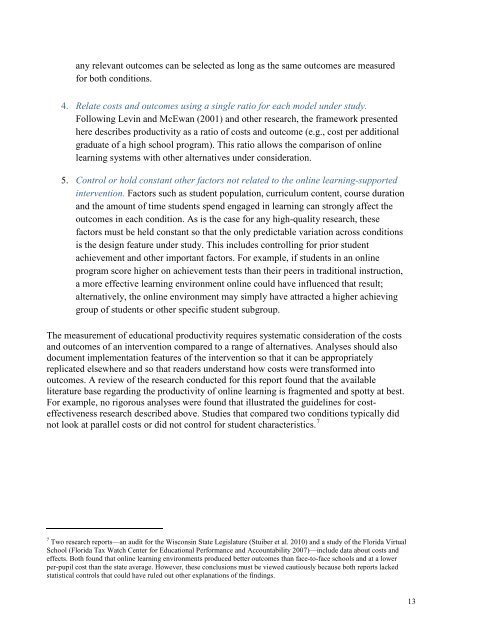Download PDF - SRI International
Download PDF - SRI International
Download PDF - SRI International
Create successful ePaper yourself
Turn your PDF publications into a flip-book with our unique Google optimized e-Paper software.
any relevant outcomes can be selected as long as the same outcomes are measured<br />
for both conditions.<br />
4. Relate costs and outcomes using a single ratio for each model under study.<br />
Following Levin and McEwan (2001) and other research, the framework presented<br />
here describes productivity as a ratio of costs and outcome (e.g., cost per additional<br />
graduate of a high school program). This ratio allows the comparison of online<br />
learning systems with other alternatives under consideration.<br />
5. Control or hold constant other factors not related to the online learning-supported<br />
intervention. Factors such as student population, curriculum content, course duration<br />
and the amount of time students spend engaged in learning can strongly affect the<br />
outcomes in each condition. As is the case for any high-quality research, these<br />
factors must be held constant so that the only predictable variation across conditions<br />
is the design feature under study. This includes controlling for prior student<br />
achievement and other important factors. For example, if students in an online<br />
program score higher on achievement tests than their peers in traditional instruction,<br />
a more effective learning environment online could have influenced that result;<br />
alternatively, the online environment may simply have attracted a higher achieving<br />
group of students or other specific student subgroup.<br />
The measurement of educational productivity requires systematic consideration of the costs<br />
and outcomes of an intervention compared to a range of alternatives. Analyses should also<br />
document implementation features of the intervention so that it can be appropriately<br />
replicated elsewhere and so that readers understand how costs were transformed into<br />
outcomes. A review of the research conducted for this report found that the available<br />
literature base regarding the productivity of online learning is fragmented and spotty at best.<br />
For example, no rigorous analyses were found that illustrated the guidelines for costeffectiveness<br />
research described above. Studies that compared two conditions typically did<br />
not look at parallel costs or did not control for student characteristics. 7<br />
7 Two research reports—an audit for the Wisconsin State Legislature (Stuiber et al. 2010) and a study of the Florida Virtual<br />
School (Florida Tax Watch Center for Educational Performance and Accountability 2007)—include data about costs and<br />
effects. Both found that online learning environments produced better outcomes than face-to-face schools and at a lower<br />
per-pupil cost than the state average. However, these conclusions must be viewed cautiously because both reports lacked<br />
statistical controls that could have ruled out other explanations of the findings.<br />
13
















